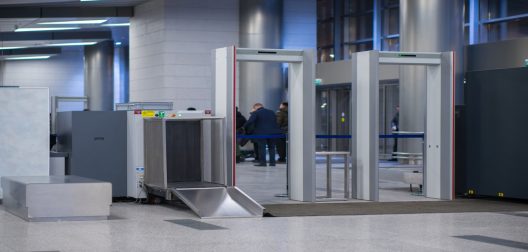- ALL PROJECTS
- Newsletters
- Press releases
- Promotional material
- Publications
28 November, 2023
The eighth issue of BorderSens newsletter is out! You can find it here. We are excited to share the successful results of our symposium, held in Antwerp on 21 November, the demonstrations of the three devices for the on-site detection of illicit drugs developed within the project, and a farewell, as our project officially ends …
Eighth (and last!) issue of BorderSens newsletter Read More »
11 October, 2023
The seventh issue of BorderSens newsletter is out! We are excited to share the new issue of our newsletter, which will keep you up to date with all the latest news of BorderSens project. Learn more about us and the work we have performed so far here. Hope you enjoy it! Remember that you can …
27 August, 2023
Illicit drug consumption constitutes a great concern worldwide due to its increased spread and abuse, and the negative consequences exerted on society. For instance, 3,4-methylenedioxymethamphetamine (MDMA), a synthetic amphetamine-type substance, was abused by 20 million people worldwide in 2020. Besides, MDMA has been used in the treatment of some psychiatric conditions. Therefore, the development of wearable devices …
23 August, 2023
Synthetic cathinones (SCs) are a group of new psychoactive substances often referred to as “legal highs” or “bath salts”, being characterized by a dynamic change, new compounds continuously emerging on the market. This creates a lack of fast screening tests, making SCs a constant concern for law enforcement agencies. In this article, in which the …
7 July, 2023
Methamphetamine (MAP) is a highly addictive and illegal stimulant drug that has a significant impact on the central nervous system. Its detection in biological and street samples is crucial for various organizations involved in forensic medicine, anti-drug efforts, and clinical diagnosis. In recent years, nanotechnology and nanomaterials have played a significant role in the development …
20 June, 2023
Our colleagues from the University of Antwerp address in this article the problem of plastic waste in research laboratories by presenting a protocol which can be used as a verification tool while designing safe, reusable labware for chemical laboratories. This protocol consists of four different steps: (i) visual inspection, (ii) mass & size comparison, (iii) …
Design for safe reuse of labware: investigating methods for quality assurance Read More »
3 May, 2023
Illicit drugs consumption remains a public threat worldwide and represents a significant challenge for the local authorities. Of these, amphetamine (AMF) is a central nervous system stimulant but in the same time a FDA approved treatment of narcolepsy and ADHD. AMF represents the second most used stimulant drug in Europe, with 1.4 million young adults …
NanoMIPs-based electrochemical sensors for selective detection of amphetamine Read More »
2 May, 2023
The sixth issue of BorderSens newsletter is out! We are excited to share the new issue of our newsletter, which will keep you up to date with all the latest news of BorderSens project. Learn more about us and the work we have performed so far here. Hope you enjoy it! Remember that you can …
13 April, 2023
The 7th press release of BorderSens project focuses on the meeting held in March in Luxembourg, where the three prototypes for the detection of illicit drugs developed within the project were successfully tested with real samples. Also, the date for the final conference was announced: it will take place on 21 November 2023 at the …
1 April, 2023
Methamphetamine (MA) is a synthetic psychoactive drug which is consumed both licitly and illicitly. In some countries it is prescribed for attention-deficit and hyperactivity disorder, and short-term treatment of obesity. More often though, it is abused for its psychostimulant properties. Unfortunately, the spread and abuse of this synthetic drug have increased globally, being reported as the most …
1 March, 2023
Electronic tongues (ETs) are multisensor systems based on the coupling of different sensors with high stability and cross-sensitivity towards different species, along with an appropriate chemometric tool that allow the classification of samples and/or the quantification of selected analytes. In a scientific article recently published by the Autonomous University of Barcelona (UAB) in Atalanta, a …
A priori tailored selection of sensor arrays for electronic tongues Read More »
10 February, 2023
The 6th press release of BorderSens project focuses on the demonstration of the BorderSens device given to the Belgian Minister for Interior, Institutional Reforms and Democratic Renewal, the European Commissioner for Home Affairs and the EMCDDA Director at the harbour of Antwerp (Belgium). Download Document
8 February, 2023
Identifying and quantifying MDMA on-site in suspected illicit drug samples is a major challenge for law enforcement agencies (LEAs). Various analytical techniques exist to fulfil this goal, e.g. colourimetry and portable spectroscopic techniques, each having its specific limitations and strengths. In this work, prepared by the University of Antwerp and the National Institute for Criminalistics …
10 January, 2023
Cannabis sativa L. is the most used recreational drug worldwide. Herbal Cannabis consists of a variable a complex matrix, which makes it challenging to properly seize and prepare the sample for qualitative and quantitative analysis. In an article recently published by the National Institute of Criminalistics and Criminology (NICC) in WIREs Forensic Science, detailed information …
2 November, 2022
Just as important as detecting drugs is the detection of precursors, i.e. chemicals necessary for their manufacture, as they are essential to prevent trafficking and drug manufacture in clandestine laboratories. In a scientific article recently published by the University of Antwerp and the National Institute of Criminalistics and Criminology (NICC) in Electrochimica Acta, the feasibility …
20 July, 2022
The fifth issue of BorderSens newsletter is out! We are excited to share the new issue of our newsletter, which will keep you up to date with all the latest news of BorderSens project. Learn more about us and the work we have performed so far here. Hope you enjoy it! Remember that you can …
16 May, 2022
In this work, performed by the University of Antwerp, the National Institute for Criminalistics and Criminology, Swedish Customs Laboratory and Dutch Customs Laboratory, a highly practical paraformaldehyde (PFA)-coated sensor, which unlocks the detectability of primary amines through derivatization, is developed for the on-site detection of amphetamine (AMP) in seized drug samples. A potential interval was …
13 May, 2022
This work presents the results of a novel application for the fast on-site screening of cocaine and its main cutting agents in suspicious and confiscated samples. The methodology behind the novel application consists of portable electrochemical detection coupled with a peak recognition algorithm for automated result output generation, validated both in laboratory and field settings. …
22 April, 2022
This article, prepared by the University of Antwerp (UA) and the National Institute for Criminalistics and Criminology (NICC), presents an electrochemical device that uses affordable screen-printed electrodes for the electrochemical profiling of several illicit drugs by square-wave voltammetry (SWV). The identification of the illicit compound is based on the oxidation potential of the analyte. The …
17 March, 2022
The fourth issue of BorderSens newsletter is out! We are excited to share the new issue of our newsletter, which will keep you up to date with all the latest news of BorderSens project. Learn more about us and the work we have performed so far here. Hope you enjoy it! Remember that you can …
3 March, 2022
The 5th press release of BorderSens project contains information about the plenary meeting held in Cluj-Napoca (Romania) on February 2022. Download Document
3 January, 2022
In the present work, carried out by the Autonomous University of Barcelona (UAB) and the University of Antwerp (UA) the resolution and quantification of mixtures of different opiate compounds in the presence of common cutting agents using an electronic tongue (ET) is evaluated. More specifically, ternary mixtures of heroin, morphine and codeine were resolved in the presence of …
23 December, 2021
This article, prepared by the University of Antwerp (UA) and the National Institute for Criminalistics and Criminology (NICC), describes the development of an electrochemical screening strategy for 3,4-methylenedioxymethamphetamine (MDMA), the regular psychoactive compound in ecstasy (XTC) pills. The research team has investigated the specific electrochemical profile of MDMA and its electro-oxidation mechanisms at disposable graphite …
16 December, 2021
The 4th press release of BorderSens project focuses on the promising results of BorderSens device during the tests performed at end-users' sites. Download Document
2 December, 2021
The University of Antwerp, together with other relevant entities, has recently participated in a research that involves a novel strategy for electrochemical detection of MDMA and 2C-B in ecstasy pills. The applicability of the approach was demonstrated with 71 ecstasy tablets seized by the Amsterdam police. Most notably, correct results were also obtained for dark colored …
19 November, 2021
Our colleagues from the Iuliu Haţieganu University of Medicine and Pharmacy Cluj-Napoca and the University of Antwerp have recently published a review on contributions to amphetamine-type substances (ATS) analysis. This type of synthetic illicit drugs has been increasingly present worldwide reaching 5% of the market on illicit drugs in 2019. The increment of their production in …
3 November, 2021
Cannabis sativa L. is widely used as recreational illegal drugs. Illicit Cannabis profiling, comparing seized samples, is challenging due to natural Cannabis heterogeneity. The aim of this study, in which National Institute for Criminalistics and Criminology (NICC) has participated, was to use GC–FID and GC–MS herbal fingerprints for intra (within)- and inter (between)-location variability evaluation. …
Gas Chromatographic Fingerprint Analysis for the Comparison of Seized Cannabis Samples Read More »
19 October, 2021
A recent work prepared by researchers from the Autonomous University of Barcelona (UAB) and the University of Antwerp reports for the first time the qualitative analysis for the determination of three drugs of abuse (heroin, morphine and codeine) and their corresponding cutting agents (caffeine and paracetamol) combining the use of modified screen-printed electrodes for voltammetric …
6 September, 2021
Unraveling the valuable information hidden within complex data, and making that information understandable to non-experts, is a difficult task many scientists in (bio)analysis are confronted with when turning a scientific technology into a (bio)analytical application. Commonly, an expert in the research field is the only one capable of understanding and interpreting the complex data generated …
11 August, 2021
Portable Electrochemical Detection of Illicit Drugs in Smuggled Samples: Towards More Secure Borders
Illicit drug consumption is posing critical concerns in our society causing health issues, crime-related activities, and the disruption of the border trade. The smuggling of illicit drugs urges the development of new tools for rapid on-site identification in cargos. Current methods used by law enforcement offices rely on presumptive color tests and portable spectroscopic techniques. …
16 July, 2021
The third issue of BorderSens newsletter is out! We are excited to share the third issue of our newsletter, which will keep you up to date with all the latest news of BorderSens project. Learn more about us and the work we have performed so far here. Hope you enjoy it! Remember that you can …
23 March, 2021
Nanomaterials have gained much attention over the last decade in the development of sensors for a myriad of applications. Within BorderSens, the applicability of carbon-based nanomaterials has been identified as highly suitable for the detection of illicit drugs. In a paper prepared by researchers from the University of Medicine and Pharmacy Iuliu Hatieganu Cluj-Napoca and …
19 March, 2021
Did you know that amphetamine (AMP) is one of the most encountered drugs-of-abuse in the current illicit market? This means that the development of new tools for its rapid on-site determination is needed. However, the direct electrochemical detection of AMP is a challenge because the molecule is non-electroactive at the potential window of conventional graphite …
3 March, 2021
The emergence of new psychoactive drugs in the market demands rapid and accurate tools for the on-site classification of illegal and legal compounds with similar structures. In a new article prepared by our colleagues from the AXES group of the University of Antwerp and the National Institute of Criminalistics and Criminology (NICC), which can be …
17 February, 2021
The second issue of BorderSens newsletter is out! We are excited to share the second issue of our newsletter, which will keep you up to date with all the latest news of BorderSens project. Learn more about us and the work we have performed so far here. Hope you enjoy it! Remember that you can …
15 February, 2021
The third press release of BorderSens project focuses on the third BorderSens project meeting, that took place online on 11 February 2021. Download Document
29 January, 2021
As a result of the research activities being carried out within BorderSens project, new knowledge continues to be generated about electrochemical fingerprints of drugs of abuse, aimed at allowing their selective detection in street samples by means of electrochemical pretreated screen printed electrodes.
26 November, 2020
The second press release of BorderSens project includes main outcomes achieved during the 1st year of the project. Download Document
4 November, 2020
Researchers from the University of Medicine and Pharmacy Iuliu Hatieganu Cluj-Napoca and the University of Antwerp, both involved in BorderSens project, have recently published a paper in Frontiers in Chemistry where some of the results of their work within the project have been included. This review discusses the types of commonly abused drugs and their …
15 October, 2020
The University of Antwerp, who coordinates BorderSens project, has participated, together with other relevant entities, in the preparation of an article entitled "Wearable Electrochemical Sensors for the Monitoring and Screening of Drugs". This article reviews for the first time wearable electrochemical sensors for monitoring therapeutic drugs and drugs of abuse, including future prospects of these …
Wearable Electrochemical Sensors for the Monitoring and Screening of Drugs Read More »
4 September, 2020
The first issue of BorderSens newsletter is out! We are excited to share the first issue of our newsletter, which will keep you up to date with all the latest news of BorderSens project. Learn more about us and the work we have performed so far here. Hope you enjoy it! Remember that you can …
31 August, 2020
The University of Antwerp, National Institute of Criminalistics and Criminology (NICC) and Dutch Customs Laboratory, all of them members of BorderSens consortium, have recently published an article entitled "Identifying electrochemical fingerprints of ketamine with voltammetry and LC-MS for its detection in seized samples". Herein, a straightforward electrochemical approach for the determination of ketamine in street …
3 April, 2020
Detailed information on the BorderSens device for the detection of illicit drugs and precursors, including main features, technologies involved and how it will work. Also, a comparison between different types of drug detection devices and main challenges of commercial tests have been included. Download Document
28 February, 2020
This deliverable, available here, is the result of the initial planning and strategy development activities performed within the framework of work package 8 (WP8) “Dissemination and exploitation” of BorderSens project, and, more specifically, of task 8.1 “Development of communication and dissemination plan”, led by IZERTIS and with the participation of the rest of the consortium …
Deliverable 8.1: Development of dissemination and communication plan Read More »
25 November, 2019
General overview of BorderSens project, including main aim, technologies involved, brief description of the consortium, and means of contact. Download Document
3 October, 2019
The first press release of BorderSens project, prepared and released coinciding with BorderSens KO meeting, focuses on disseminating general information and main aim of the project. Download Document
20 September, 2019
Slide presentation including BorderSens project main objective, consortium, budget, and duration. Download Document






















